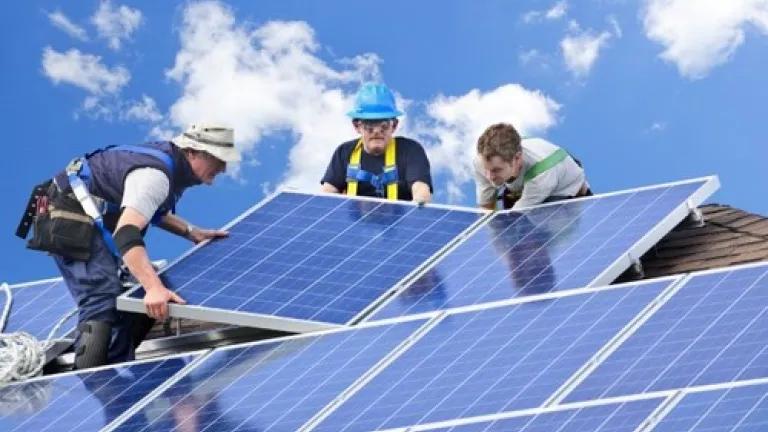
Americans love solar and recognize that beyond producing energy it powers us toward greater energy independence, combats global warming and lowers our utility bills. Getting a grid-connected home solar electric system up and running shouldn't be particularly hard or time-consuming. Construction, on average, takes about two days. Yet, a report published recently by the National Renewable Energy Laboratory finds utilities often take more than a month and a half--an average of 52 days, actually--to connect residential solar systems to the electric grid, even though the process is about as complicated as installing cable TV. That's unfortunate, because a lengthy timetable slows the deployment of solar around the country, bumps up the cost of pollution-free power systems, and even threatens the viability of small and mid-sized solar installers. Think about it: "Time is money," explains Sara Baldwin Auck, director of the regulatory program at the Interstate Renewable Energy Council (IREC), a non-profit resource on renewable energy technologies. "Longer processes mean higher costs that are often transferred to the end users." In other words, to you and me.
There's a simple fix for this problem, though. And it involves utilities and the public service commissions (PSCs) that regulate them taking an active role. Utilities can streamline and fast-track the interconnection process, by, to begin with, enabling developers to be aware of potential interconnection issues before they start. And, by expediting small projects that rarely require extensive review. The PSCs that regulate utilities can require these provisions as well, allowing most residential solar systems to connect to the grid in a matter of days, not months, all while ensuring safety and reliability.
Interconnection--the hooking up of a solar system to the electric grid--might seem like one of those wonky issues that is hopelessly technical or complicated. Electric grids, after all, are complex things. But research and the experiences of many utilities and solar developers shows that the process is often relatively simple and requires little study. "For the vast majority of small, net-metered systems," says Baldwin Auck, "the system can be reviewed in a matter of hours, or even minutes." IREC develops guidelines that are best practices for the industry. And it believes that most residential systems should be put on a fast track with reviews that can be completed in less than a month, because small systems have relatively little impact on the reliability of local electric grids. The organization is not the only one that has reached this conclusion. The Federal Energy Regulatory Commission, the government agency tasked with regulating interstate energy transmission, agrees. It's develop what it calls "small generator interconnection procedures" (SGIPs) that encourage fast-tracking and apply to distributed generation systems in areas it regulates.
Delays in interconnections can have big impacts. To begin with, slow interconnection processes can add hundreds of dollars to the cost of a residential solar system. And, despite the increasingly low cost of solar, those extra dollars can mean fewer interested homeowners can afford the price. Once panels are up on roofs, the wait in getting customers connected to the grid can mean less cost-savings and a lot of frustration, something that can give both the solar and utility industry a black eye. "For a lot of customers, going solar is a once-in-a-lifetime experience," says Evan Conley, manager of business development at NRG Home Solar. "To have the panels put up and then not hear from the developers for months, because they're waiting for the interconnection is frustrating to say the least." Developers like NRG are concerned such experiences may put some off from buying solar. Moreover, slow interconnection rates mean developers need to tie up their capital in inventory while they wait for the systems to become operational and for their customers to pay them. "NRG is not as cash-constrained as many players in the market," Conley says. "But inventory can kill small and medium-sized companies."
To address the slow speed of many interconnection processes, a handful of states have what IREC terms "best practice" interconnection rules. "California has what's considered to be the gold standard," Baldwin Auck explains. The state's policy allows applications to be submitted electronically, so solar employees don't have to waste hours in line waiting to turn in paperwork. There's a fast-tracked review process for small solar systems. And, "they're working toward making their grid information available to solar developers, so they can know whether connecting a system at a particular location might cause a problem that would require lengthy review." Massachusetts and Ohio also follow these best practices.
Addressing inefficiencies in the interconnection process as solar begins to go mainstream makes sense for all of us--homeowners, grid operators, solar developers, and, of course, the nation as a whole. After all, the benefits residential and other small solar systems offer are very well-documented--cost-savings on energy, a more stable and reliable grid, good-paying jobs, and pollution-free electricity. It behooves us to deploy these systems as quickly as possible. NREL's report shows there are opportunities to do that almost everywhere, when utilities and public service commissions decide to act.
